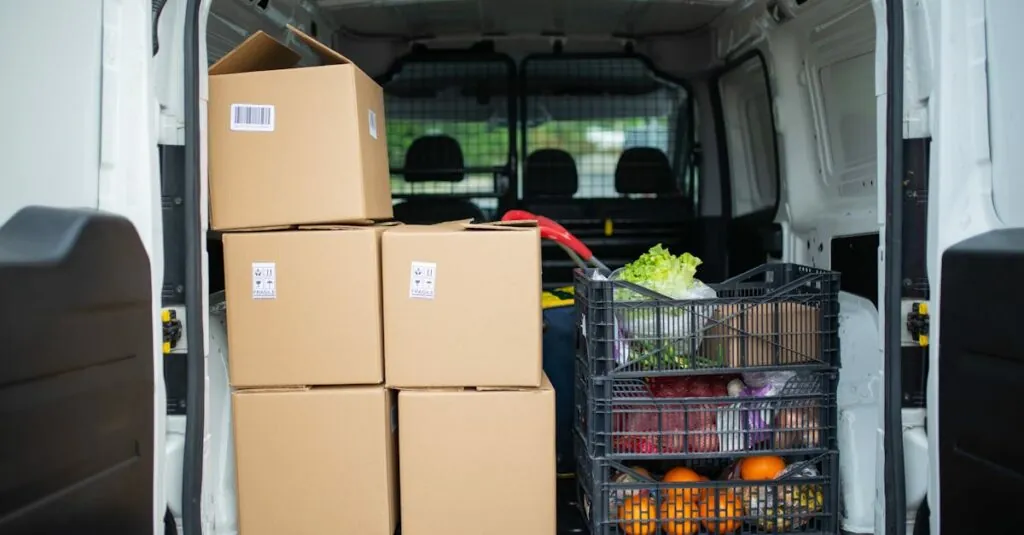Table of Contents
ToggleIn a world where every delivery feels like a race against time, green logistics emerges as the unsung hero, combining efficiency with eco-friendliness. Imagine a logistics system that not only gets your package to your doorstep but also leaves Mother Nature giving a thumbs-up. It’s like having your cake and eating it too—without the guilt of plastic forks!
As businesses scramble to reduce their carbon footprints, the shift towards sustainable practices isn’t just a trend; it’s a necessity. Green logistics embraces innovative strategies, from eco-friendly packaging to electric delivery vehicles, proving that being kind to the planet can also be good for the bottom line. So buckle up for a journey into the greener side of logistics, where saving the Earth and boosting profits go hand in hand, and every shipment is a step towards a brighter future.
What Is Green Logistics?
Green logistics refers to the integration of environmentally friendly practices within the logistics and supply chain sectors. This approach prioritizes reducing negative environmental impacts while maintaining efficiency in the delivery process. Businesses implement various strategies such as optimizing routes and minimizing waste to achieve sustainability goals.
Utilizing eco-friendly packaging materials significantly reduces waste. Companies often choose biodegradable or recyclable options, decreasing their carbon footprint. Electric delivery vehicles contribute to cleaner transport methods. These vehicles not only cut emissions but also lower operating costs in the long run.
Reducing energy consumption forms another key aspect of green logistics. Businesses actively seek technologies that optimize warehouse operations and transportation. Adopting renewable energy sources for powering facilities illustrates commitment to sustainability.
Implementing a circular economy is essential in promoting green logistics. Products are designed for reuse, recycling, or responsible disposal. This shift encourages businesses to rethink their entire supply chain, focusing on lifecycle management and waste reduction.
Collaboration between stakeholders enhances the effectiveness of green logistics initiatives. Partnerships with suppliers and consumers foster transparency and promote sustainable practices across the value chain. Involving all players increases awareness and encourages shared responsibility for environmental stewardship.
Green logistics is increasingly recognized as a vital component for future success. Anticipating regulations and consumer preferences drives companies to adopt sustainable practices. Meeting these expectations not only benefits the planet but also improves brand reputation and customer loyalty.
Importance Of Green Logistics
Green logistics plays a critical role in promoting sustainability while enhancing operational efficiency. Its significance grows as businesses seek eco-friendly solutions.
Environmental Impact
Reducing greenhouse gas emissions remains a primary goal of green logistics. Embracing electric delivery vehicles significantly cuts carbon footprints, helping the planet. Minimizing waste through comprehensive recycling programs also contributes to environmental health. Utilizing biodegradable packaging reduces landfill contributions, supporting wildlife and natural habitats. Implementing energy-efficient technologies within warehouses decreases energy consumption, lowering overall environmental strain. By integrating sustainable practices, companies demonstrate commitment to preserving ecosystems while maintaining productivity.
Economic Benefits
Lowering operating costs emerges as a key economic advantage of green logistics. Electric vehicles lead to savings in fuel costs, generating financial flexibility. Efficient route optimization minimizes fuel consumption, enabling quicker deliveries. Businesses benefit from improved brand reputation, attracting eco-conscious consumers who prefer sustainable options. Investing in green logistics creates opportunities for public grants and subsidies aimed at supporting renewable initiatives. Companies that adopt these practices often see increased customer loyalty, translating into higher sales.
Strategies For Implementing Green Logistics
Implementing green logistics involves various strategies focused on sustainability and operational efficiency.
Sustainable Transportation
Adopting electric vehicles reduces emissions significantly. Companies can also explore alternative fuel options to further decrease their carbon footprints. Route optimization software helps reduce fuel consumption, improving overall efficiency. Using public transportation for urban deliveries minimizes road congestion and emissions. Additionally, partnering with suppliers that prioritize sustainability enhances the logistics chain’s green credentials.
Eco-Friendly Packaging
Biodegradable packaging materials offer a sustainable alternative to traditional plastic. Companies can implement reusable packaging systems to minimize waste effectively. Encouraging customers to return or recycle packaging promotes a circular economy. Sustainable packaging not only protects products but also strengthens brand image. Evaluating suppliers based on their packaging practices ensures a shared commitment to environmental stewardship.
Warehouse Efficiency
Implementing energy-efficient technologies in warehouses reduces overall energy consumption. Smart inventory management systems help optimize storage space and reduce waste. Utilizing renewable energy sources like solar power provides sustainable energy solutions. Regular audits of warehouse operations identify areas for emissions reduction. Training staff on sustainable practices reinforces the commitment to green logistics within the organization.
Challenges In Green Logistics
Green logistics faces numerous challenges that impact its implementation and effectiveness. Two significant hurdles include cost constraints and technology adoption.
Cost Constraints
Cost constraints present a significant barrier to adopting green logistics practices. Many businesses perceive eco-friendly options as more expensive than traditional methods. For instance, electric delivery vehicles often involve higher upfront costs compared to conventional vehicles. Smaller companies may struggle to absorb these expenses while maintaining competitive pricing. Additionally, investments in sustainable packaging and energy-efficient technologies may yield long-term savings but require immediate financial commitments. Balancing these costs against potential benefits can deter businesses from pursuing green logistics initiatives.
Technology Adoption
Technology adoption influences the growth of green logistics considerably. Many companies face challenges integrating new technologies. Advanced route optimization software and energy-efficient warehouse systems necessitate upfront investments and staff training. Resistance to change can also occur within organizations, particularly if employees are accustomed to traditional practices. Furthermore, the rapid evolution of technology complicates decision-making, as businesses aim to choose the most effective and sustainable solutions. Overcoming these technological hurdles is essential for the successful implementation of green logistics strategies.
Future Trends In Green Logistics
Green logistics is evolving rapidly, with several key trends shaping its future. Innovations in technology play a pivotal role in this transformation, enhancing sustainability in logistics.
Innovations In Technology
Technological advancements drive green logistics forward. Artificial intelligence streamlines route optimization, reducing fuel consumption. Drones and automation improve last-mile delivery efficiency, allowing for quicker transactions with less environmental impact. Blockchain technology enhances transparency in supply chains, tracking carbon footprints and ensuring sustainability compliance. Battery advancements in electric vehicles increase their range and efficiency, making them more viable for logistics networks. These innovations lead logistics companies toward a greener future by decreasing emissions.
Regulatory Changes
Regulatory changes significantly impact green logistics practices. Governments worldwide impose stricter emissions standards, compelling companies to adopt cleaner alternatives. Incentives for using electric vehicles and investing in renewable energy sources emerge as a response to climate concerns. Many regions now implement new packaging regulations aimed at reducing waste, encouraging businesses to evaluate their materials. Compliance with these regulations promotes a shift toward sustainability, aligning corporate goals with environmental responsibilities. Adaptation to these changes is essential for businesses aiming to remain competitive.
Conclusion
Embracing green logistics is no longer just an option; it’s a necessity for businesses aiming to thrive in today’s environmentally conscious market. By integrating sustainable practices into their operations, companies can significantly reduce their carbon footprints while enhancing efficiency. The shift towards eco-friendly packaging and electric vehicles not only benefits the planet but also offers economic advantages such as lower operating costs and improved brand loyalty.
As technology continues to advance, businesses must stay ahead of the curve by adopting innovative solutions that promote sustainability. Collaboration among stakeholders is crucial for maximizing the impact of green logistics initiatives. Ultimately, those who prioritize eco-friendly practices will not only contribute to a healthier planet but also position themselves as leaders in their industry.







